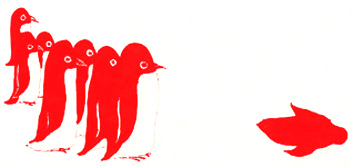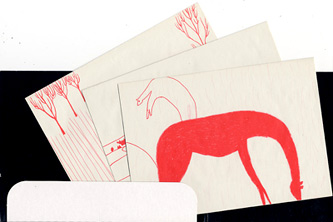
By Yukari Miyagi
When I began drawing "Chichi" it was a great challenge for me. Because I wanted to draw it in a way that would reduce brushstrokes as much as possible. I just wanted to draw it in the simplest way. *I started to draw it with a minimum of strokes. This challenge was very hard for me at first. But the difficulty gradually softened, and when it began to change into pleasure and curiosity, I arrived at the land of "Chichi" as if I had been led there by something great. And then I drew more and more. I learned how to draw by this work. My ability of drawing with a minimum of strokes is developing now, and it resulted in my third work, "Ambrosia".
*notes: She writes "I started to draw it with only one line if it's possible" in Japanese.
Author's Bio:
She started her career as a freelance illustrator in 1992. Her works appeared in magazines and other media. She published "Reminiscence" as a private edition in 1998. She published "Chichi" in 1999, and "Ambrosia"in 2002.
Yukari Miyagi website (started in April 2007)
*Her new drawings are available on "The Land of Little Rain" (started in July 2008)
#2 From The Editor
It was the summer of 2002 when I found Yukari Miyagi's work, "Chichi", at the bookstore in Shibuya, Tokyo. Opening the cover of the book, which was made of a cardboard in portfolio style, a desert landscape drawn with only red lines on a non-bleached color paper appeared in front of me. I may have said "oh!" or something thoughtlessly. Familiarity, curiosity and sympathy came to my mind. As I felt the drawing connected directly with my recent work translating literature of the American South West. As I turned the drawings of "Chichi", every five drawings were folded up in one long piece of paper, desert landscapes and creatures(they seem to be primitive ones) appeared one after the other. Though they were drawn simply in only red lines, they gave a strong impression. And though they were free from actual time and place, they surely existed with reality somewhere on the earth. I felt so. It didn't take much time to relate these two elements, American Indian poems "The Deer-Star" and "Chichi".
Later, when I spoke with Yukari on the phone I was so surprised to hear that "Chichi" was inspired by one scene in one of Jim Jarmusch's films(the scene was the landscape seen from the train's window). The film dealt with the pioneer age of America, and overlapped our work, "The Deer-Star" both in time and space. (Kazue Daikoku)



Dimensions (in inches): 7.8 x 10.5/1000yen, U.S.A. $9.00, EUR9,00)
*Sorry, we're sold out of the book "Chichi".